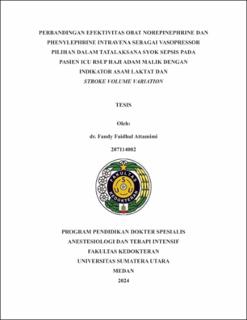| dc.contributor.advisor | Wijaya, Dadik Wahyu | |
| dc.contributor.advisor | Tanjung, Qadri F | |
| dc.contributor.author | Attamimi, Fandy Faidhul | |
| dc.date.accessioned | 2025-01-22T06:44:52Z | |
| dc.date.available | 2025-01-22T06:44:52Z | |
| dc.date.issued | 2024 | |
| dc.identifier.uri | https://repositori.usu.ac.id/handle/123456789/100462 | |
| dc.description.abstract | Background: Septic shock is a critical condition that requires intensive management with the use of vasopressors to maintain organ perfusion. Norepinephrine and phenylephrine are two commonly used vasopressors, but their relative effectiveness in the context of septic shock remains debated. This study aims to determine the differences in the effectiveness of intravenous norepinephrine and phenylephrine as vasopressor options in managing septic shock in ICU patients at RSUP Haji Adam Malik Medan, using lactate levels and stroke volume variation as indicators. Methods: This study was conducted with a randomized controlled trial (RCT) design. The subjects were ICU patients at RSUP HAM with a diagnosis of septic shock who received norepinephrine or phenylephrine as vasopressors. Evaluations were conducted on changes in lactate levels and SVV at the start of therapy and at certain intervals during the treatment period. Data were analyzed using appropriate statistical methods to compare the effects of the two vasopressors. Results: The study included 32 samples divided into two groups: norepinephrine and phenylephrine, with 16 patients in each group. Norepinephrine administration for 6 hours significantly reduced lactate levels from 8.41±1.88 mmol/L to 5.76±1.99 mmol/L. There was also a decrease in Stroke Volume Variation (SVV) from 14.25±2.17 mmHg to 8.18±1.90 mmHg, with statistically significant results (p<0.001). Phenylephrine administration for 6 hours also reduced lactate levels from 7.40±1.77 mmol/L to 6.70±1.77 mmol/L. SVV values decreased from 15.93±2.56 mmHg to 12.50±2.63 mmHg, with significant statistical values (p<0.001). Conclusion: Intravenous norepinephrine is more effective than phenylephrine in reducing lactate levels and improving stroke volume variation in ICU patients with septic shock. These findings support the use of norepinephrine as the primary vasopressor choice in managing septic shock, although phenylephrine can still be used as an alternative with close monitoring of hemodynamic parameters. Further studies are needed to confirm these results and explore the underlying mechanisms of the differences in effectiveness. | en_US |
| dc.language.iso | id | en_US |
| dc.publisher | Universitas Sumatera Utara | en_US |
| dc.subject | Septic shock | en_US |
| dc.subject | Norepinephrine | en_US |
| dc.subject | Phenylephrine | en_US |
| dc.subject | Lactate levels | en_US |
| dc.subject | Stroke Volume Variation | en_US |
| dc.title | Perbandingan Efektivitas Obat Norepinephrine dan Phenylephrine Intravena sebagai Vasopressor Pilihan dalam Tatalaksana Syok Sepsis pada Pasien ICU RSUP Haji Adam Malik dengan Indikator Asam Laktat dan Stroke Volume Variation | en_US |
| dc.title.alternative | Comparison of The Effectiveness of Norepinephrine and Phenylephrine Intravenously as First-Choice Vasopressors in The Management of Septic Shock in ICU Patients at RSUP Haji Adam Malik, with Indicators of Lactic Acid and Stroke Volume Variation | en_US |
| dc.type | Thesis | en_US |
| dc.identifier.nim | NIM207114002 | |
| dc.identifier.kodeprodi | KODEPRODI11751#Anestesiologi dan Terapi Intensif | |
| dc.description.pages | 147 Pages | en_US |
| dc.description.type | Tesis Magister | en_US |
| dc.subject.sdgs | SDGs 3. Good Health And Well Being | en_US |


